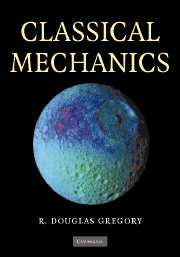Book contents
- Frontmatter
- Contents
- Preface
- 1 Newtonian mechanics of a single particle
- 1 The algebra and calculus of vectors
- 2 Velocity, acceleration and scalar angular velocity
- 3 Newton's laws of motion and the law of gravitation
- 4 Problems in particle dynamics
- 5 Linear oscillations
- 6 Energy conservation
- 7 Orbits in a central field
- 8 Non-linear oscillations and phase space
- 2 Multi-particle systems
- 3 Analytical mechanics
- 4 Further topics
- Appendix Centres of mass and moments of inertia
- Answers to the problems
- Bibliography
- Index
3 - Newton's laws of motion and the law of gravitation
Published online by Cambridge University Press: 05 September 2012
- Frontmatter
- Contents
- Preface
- 1 Newtonian mechanics of a single particle
- 1 The algebra and calculus of vectors
- 2 Velocity, acceleration and scalar angular velocity
- 3 Newton's laws of motion and the law of gravitation
- 4 Problems in particle dynamics
- 5 Linear oscillations
- 6 Energy conservation
- 7 Orbits in a central field
- 8 Non-linear oscillations and phase space
- 2 Multi-particle systems
- 3 Analytical mechanics
- 4 Further topics
- Appendix Centres of mass and moments of inertia
- Answers to the problems
- Bibliography
- Index
Summary
KEY FEATURES
The key features of this chapter are Newton's laws of motion, the definitions of mass and force, the law of gravitation, the principle of equivalence, and gravitation by spheres.
This chapter is concerned with the foundations of dynamics and gravitation. Kinematics is concerned purely with geometry of motion, but dynamics seeks to answer the question as to what motion will actually occur when specified forces act on a body. The rules that allow one to make this connection are Newton's laws of motion. These are laws of physics that are founded upon experimental evidence and stand or fall according to the accuracy of their predictions. In fact, Newton's formulation of mechanics has been astonishingly successful in its accuracy and breadth of application, and has survived, essentially intact, for more than three centuries. The same is true for Newton's universal law of gravitation which specifies the forces that all masses exert upon each other.
Taken together, these laws represent virtually the entire foundation of classical mechanics and provide an accurate explanation for a vast range of motions from large molecules to entire galaxies.
NEWTON'S LAWS OF MOTION
Isaac Newton's three famous laws of motion were laid down in Principia, written in Latin and published in 1687. These laws set out the founding principles of mechanics and have survived, essentially unchanged, to the present day. Even when translated into English, Newton's original words are hard to understand, mainly because the terminology of the seventeenth century is now archaic.
- Type
- Chapter
- Information
- Classical Mechanics , pp. 50 - 72Publisher: Cambridge University PressPrint publication year: 2006



